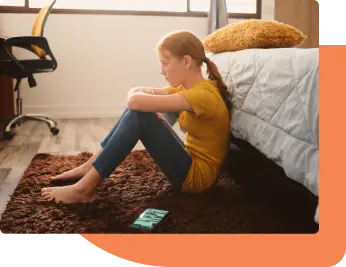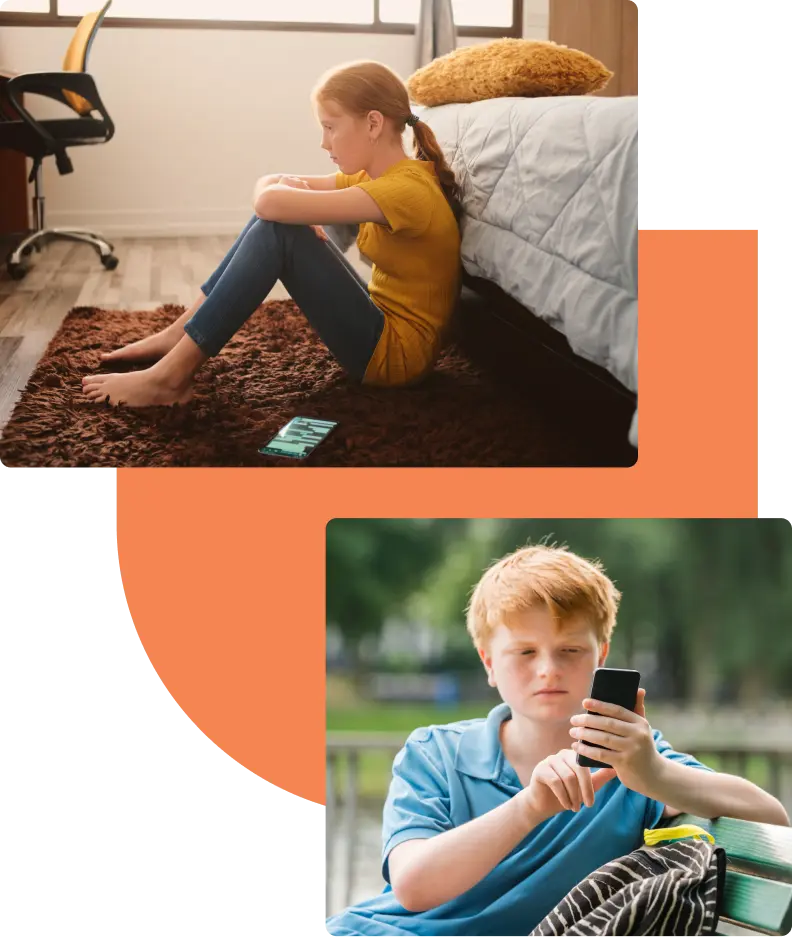Troomi Parent Academy
Understanding Technology and Teen Mental Health: A Parent's Guide
Author: Jodi Kunz
October 2, 2024

Introduction to the Relationship Between Technology and Teen Mental Health
We all want the best for our kids. As parents, we need to think about the mental health of teens in their teenage years. With technology all around, it is imperative to understand its impact on them. How does the digital world shape their thoughts and feelings?
This guide will look at the link between technology and teen mental health. It provides helpful insights and resources for parents. We’ll see how it influences mental health. By practicing good habits and encouraging open talks in your home, you will be helping your teenager thrive online.






Understanding Teen Mental Health
Mental health is as important as physical health. Parents should help their teens with mental health. These years impose many challenges as teens face friendships, peer pressure, and body image issues. All these factors can lead to stress and anxiety.
The common problems that one would undergo during teenage years are anxiety, depression, and low self-esteem. Teenagers generally find it hard to open up about their feelings. This makes it harder for parents to recognize issues.
Keeping communication open is one way to cope with teenagers. Encourage your teens to express their thoughts. They should feel safe sharing without judgment. When you understand their struggles, you can offer better support. A strong support system helps teens manage emotions. It also builds resilience. This support is crucial for healthy growth during these essential years.
Keeping communication open is one way to cope with teenagers. Encourage your teens to express their thoughts.
Keeping communication open is one way to cope with teenagers. Encourage your teens to express their thoughts.

The Rise of Technology
Screen Time and Mental Health of Teenagers
High screen time is linked to poor teen mental health outcomes. The American Academy of Pediatrics recommends teens limit screen use to two hours daily. Overusing screens can disturb sleep and reduce physical activity. It can also heighten feelings of loneliness. Keeping screen time in check is crucial for better mental health.

Sleep Disruption
Many teens spend time on their phones late at night. This habit can disturb their sleep patterns. The blue light emitted by screens disrupts melatonin production. Consequently, falling asleep becomes more difficult. Sleep deprivation can lead to emotional issues and impaired thinking. Both of these factors negatively impact mental health.
The Importance of Balance
Encouraging a balanced attitude toward screen use is vital. Promote screen-free activities such as reading, playing sports, and spending time with family. These activities can be fulfilling and beneficial. Maintaining a healthy mix of online and offline time can greatly aid in protecting their mental health.
Encouraging Open Conversations
Open discussions about screen use can strengthen the parent-child relationship. Provide a safe space for your teen to express their views on technology. Encourage them to share their experiences and challenges online. This dialogue will help parents guide their teens more effectively in navigating the digital world.
Setting Healthy Boundaries
It’s essential to set realistic screen time limits for mental wellness. Consider establishing family guidelines, such as tech-free hours or specific areas in your home. Encourage your teen to take part in offline activities during screen time. These limits will support overall well-being and promote a healthy relationship with technology.

Common Mental Health Issues of Teenagers
Some common teen mental health issues include:

Setting Healthy Boundaries
Anxiety disorders are common among teenagers. They can cause undue anxiety or dread. Many teens experience social anxiety, making it difficult to interact with their peers. This may result in avoiding social contact. According to the National Institute of Mental Health, around 31.9% of teens aged 13 to 18 have anxiety problems. This condition can influence both their social lives and their academic performance.
Depression
Depression affects a significant proportion of teenagers. It frequently appears as depression, pessimism, or irritability. These emotions may interfere with normal activity. Teenagers may withdraw from their classmates and lose interest in things they once enjoyed. This might have an impact on their academic achievement and familial relationships. Early identification of depression is crucial for accessing therapy and support.
Attention Deficit and Hyperactivity Disorder (ADHD)
ADHD is another common disorder among teenagers. It reduces concentration and impulsive control. Teens who have ADHD may struggle to focus on tasks. This can result in academic hurdles and disappointment. These issues may sometimes make social interactions challenging. Early diagnosis and intervention may help them regain confidence and cope better.
Signs of Mental Health Issues
As a parent, it's essential to recognize the signs of mental health issues in your teen. Look for:

Keep an eye out for any noteworthy changes in your teen's mood or behavior. They may become more anxious or reclusive. Sudden emotional changes, such as irritability or mood swings, might indicate a problem. If these changes last for many weeks, taking notes and getting assistance is vital.
If your child begins to withdraw from friends and family, it might be a sign of danger. They may avoid social gatherings or refuse to spend time with loved ones. This can lead to loneliness and a deterioration in mental health. Encourage open discourse so that they can better understand their feelings.
Academic performance reductions might be indicative of mental health difficulties. This might be a warning flag if your child gets bored in school or struggles to concentrate. Missed assignments or low grades may indicate more profound emotional challenges. Early treatment of these difficulties will help children restore their self-esteem and achieve academic success.
Significant changes in eating or sleeping habits are dangerous. Your teenager may sleep excessively or insufficiently. Furthermore, they might consume more or less than usual. These changes will have an impact on their energy levels and attitudes. Monitoring these activities can assist in identifying potential teen mental health issues.
Stress or emotional strain may be indicated by increased annoyance or fury. Your adolescent may act out or become upset about unimportant things. This behavior will lead to issues in friendships and family. To effectively assist them, it is essential to comprehend the cause of their rage.


Role of Technology in Teenagers’ Mental Health
While technology can contribute to mental health issues, it can also be beneficial. Here are some positive aspects of technology:

Access to Resources
There are many resources on mental health available on the internet. Teens have easy access to videos, articles, and needs-specific support groups. Their abundance of knowledge enables them to ask for assistance when necessary. Additionally, it allows students to learn about coping mechanisms and mental health concerns freely.

Connecting with Peers
Social media allows teens to connect with others who share similar experiences and challenges. This online interaction provides a sense of belonging and can reduce feelings of isolation. Through virtual communities, teens can find support and encouragement, helping them navigate their emotions and build meaningful relationships with peers.

Teletherapy
Teletherapy has gained popularity, making teen mental health services more accessible for teens. They can connect with therapists from the comfort of their homes, alleviating anxiety about seeking help in person. This convenience enables more teens to receive support and guidance when needed.
Telehealth Resources for Teen Mental Health
Here are some of the best telehealth resources for your teen’s mental health:


Teen Line
Phone: 1-800-852-8336
Website: teenlineonline.org

Crisis Text Line
Text: HOME to 741741
Website: crisistextline.org


The Trevor Project
Phone: 1-866-488-7386
Website: thetrevorproject.org


YouthLine
Phone: 1-877-968-8491
Website: youthline.ca

Mental Health America (MHA)
Phone: 1-800-969-6642
Website: mhanational.org

BetterHelp
Website: betterhelp.com


Talkspace
Website: talkspace.com


National Alliance on Mental Illness (NAMI)
Phone: 1-800-950-NAMI (6264)
Website: nami.org


7 Cups
Website: 7cups.com

SAMHSA’s National Helpline
Phone: 1-800-662-HELP (4357)


Setting Boundaries for Your Teens
Parents should set clear boundaries to use the positive aspects of technology. Here are some tips:
Strategies for Supporting Teen Mental Health
It is crucial to find a way to help your child mentally. Here are some strategies to follow:
Open Communication
Encouraging open communication is vital. Create a safe space for your teen to share their thoughts and feelings. Ask questions and listen without judgment. This can help them feel supported and understood. Open dialogues can strengthen your relationship and foster trust.
Starting the Conversation
Start conversations about mental health with empathy. Instead of waiting for your teen to bring up concerns, initiate discussions. Ask about their day, their friends, and their online experiences. By being proactive, you can create opportunities for deeper conversations.
Educate Yourself and Your Teen
Knowledge is power. Educate yourself about mental health issues. Share this information with your teen. Understanding their mental health can empower them to advocate for themselves. Provide them with resources, such as articles or videos that discuss mental health topics.


Encourage Healthy Habits
Promote a healthy lifestyle that includes:
- Physical Activity: Regular exercise can improve mood and reduce anxiety. Encourage your teen to find an activity they enjoy.
- Diet: A physical diet is essential whether physical activity is essential, such as playing sports, dancing, or simply walking. A nutritious diet can positively affect mental health. Encourage your teen to eat various fruits, vegetables, and whole grains. Discuss how certain foods can impact mood and energy levels.
- Sleep Routine: Establish a consistent sleep routine. Good sleep is essential for mental health. Encourage your teen to create a relaxing bedtime routine, limiting screen time before bed to improve sleep quality.
Building Resilience
Teaching your teen resilience can help them solve challenges more effectively. Resilience is the ability to bounce back from adversity. Encourage them to view setbacks as opportunities for growth. Teach coping strategies to manage stress, such as mindfulness or deep breathing exercises.
Encouraging Problem-Solving Skills
Help your teen develop problem-solving skills. Discuss the challenges they face and brainstorm potential solutions together. Encourage them to take ownership of their decisions and learn from their experiences.
Encourage Connections
Encourage your teen to build and maintain relationships with friends and family. Positive social connections are vital for mental well-being. Help them find opportunities to socialize through clubs, sports, or family activities.
Promoting Healthy Online Habits
Teach your teen to navigate the online world mindfully. Discuss the importance of digital well-being. Encourage them to take breaks from social media and reflect on how their online interactions make them feel.

